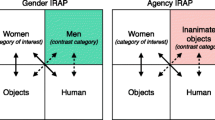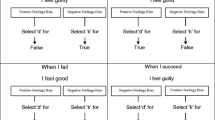Abstract
The current research comprised two experiments that employed the Implicit Relational Assessment Procedure (IRAP) as a measure of implicit racial attitudes. White Irish participants were exposed to blocks of trials that involved responding in a manner consistent with either a pro-white stereotype or a pro-black stereotype. In Experiment 1, participants completed the IRAP in either a public or private assessment situation. It was hypothesized that implicit pro-white stereotyping would decrease in the public context relative to the private context. The results, however, were not in accordance with this prediction. A second experiment was conducted to determine if requiring participants to respond in a public context but within a shorter timeframe would impact significantly upon implicit stereotyping. The results showed that a reduction in response latency significantly increased ingroup stereotyping. The findings appear to be consistent with the relational elaboration and coherence model.
Similar content being viewed by others
References
BARNES-HOLMES, D., BARNES-HOLMES, Y., POWER, P., HAYDEN, E., MILNE, R., & STEWART, I. (2006). Do you really know what you believe? Developing the Implicit Relational Assessment Procedure (IRAP) as a direct measure of implicit beliefs. The Irish Psychologist, 32, 169–177.
BARNES-HOLMES, D., BARNES-HOLMES, Y., STEWART, I., & BOLES, S. (in press). A sketch of the Implicit Relational Assessment Procedure (IRAP) and the Relational Elaboration and Coherence (REC) Model. The Psychological Record.
BARNES-HOLMES, D., HAYDEN, E., BARNES-HOLMES, Y., & STEWART, I. (2008). The Implicit Relational Assessment Procedure (IRAP) as a response-time and event-related-potentials methodology for testing natural verbal relations: A preliminary study. The Psychological Record, 58, 497–516.
BARNES-HOLMES, D., HAYES, S. C., & DYMOND, S. (2001). Self and self-directed rules. In S. C. Hayes, D. Barnes-Holmes, & B. Roche (Eds.), Relational frame theory: A post-Skinnerian account of human language and cognition (pp. 119–140). New York: Kluwer/Plenum.
BARNES-HOLMES, D., MURTAGH, L., BARNES-HOLMES, Y., & STEWART, I. (in press). Using the Implicit Association Test and the Implicit Relational Assessment Procedure to measure attitudes toward meat and vegetables in vegetarians and meat eaters. The Psychological Record.
BARNES-HOLMES, D., WALDRON, D., BARNES-HOLMES, Y., & STEWART, I. (2009). Testing the validity of the Implicit Relational Assessment Procedure (IRAP) and the Implicit Association Test (IAT): Measuring attitudes towards Dublin and country life in Ireland. The Psychological Record, 59, 389–406.
BARNES-HOLMES, Y., BARNES-HOLMES, D., & CULLINAN, V. (2001). Education. In S. C. Hayes, D. Barnes-Holmes, & B. Roche (Eds.), Relational frame theory: A post-Skinnerian account of human language and cognition (pp. 181–195). New York: Kluwer/Plenum.
BLANCHARD, F. A., CRANDALL, C. S., BRIGHAM, J. C., & VAUGHN, L. A. (1994). Condemning and condoning racism: A social context approach to interracial settings. Journal of Applied Psychology, 79, 993–997.
BOYSEN, G. A., VOGEL, D. L., & MADON, S. (2006). A public versus private administration of the Implicit Association Test. European Journal of Social Psychology, 36, 845–856.
BRIEF, A. P., DIETZ, J., COHEN, R. R., PUGH, S. D., & VASLOW, J. B. (2000). Just doing business: Modern racism and obedience to authority as explanations for employment discrimination. Organizational Behaviour and Human Decision Processes, 81, 72–97.
CULLEN, C., & BARNES-HOLMES, D. (2008). Implicit pride and prejudice: A heterosexual phenomenon? In T. G. Morrison & M. A. Morrison (Eds.), The Psychology of Modern Prejudice (pp. 195–223). New York: Nova Science.
CUNNINGHAM, W. A., PREACHER, K. J., & BANAJI, M. R. (2001). Implicit attitude measures: Consistency, stability, and convergent validity. Psychological Science, 12, 163–170.
DASGUPTA, N., MCGHEE, D. E., & GREENWALD, A. G. (2000). Automatic preference for white Americans: Eliminating the familiarity explanation. Journal of Experimental Social Psychology 36, 316–328.
DAWSON, D. L., BARNES-HOLMES, D., GRESSWELL, D. M., & GILES, D. (2009). The Implicit Relational Assessment Procedure: Assessing the implicit beliefs of sexual offenders. Sexual Abuse: A Journal of Research and Treatment, 21(1), 57–75.
DE HTOUWER, J. (2002). The Implicit Association Test as a tool for studying dysfunctional associations in psychopathology: Strengths and limitations. Journal of Behaviour Therapy and Experimental Psychiatry, 33, 115–133.
DE HTOUWER, J. (2003). The Extrinsic Affective Simon Task. Experimental Psychology, 50, 77–85.
DEUTSCH, R., KORDTS-FREUDINGER, R., GAWRONSKI, B., & STRACK, F. (2009). Fast and fragile: A new look at the automaticity of negation processing. Experimental Psychology, 56(6), 434–446.
FAZIO, R. H., SANBONMATSU, D. M., POWELL, M. C., & KARDES, F. R. (1986). On the automatic activation of attitudes. Journal of Personality and Social Psychology, 50, 229–238.
GAWRONSKI, B., & BODENHAUSEN, G. V. (2007). Unraveling the processes underlying evaluation: Attitudes from the perspective of the Ape model. Social Cognition, 25, 687–717.
GAWRONSKI, B., LEBEL, E. P., & PETERS, K. R. (2007). What do implicit measures tell us? Scrutinizing the validity of three common assumptions. Perspectives on Psychological Science, 2, 181–193.
GREENWALD, A. G., BANAJI, M. R., RUDMAN, L. A., FARNHAM, S. D., NOSEK, B. A., & MELLOTT, D. S. (2002). A unified theory of implicit attitudes, stereotypes, self-esteem, and self-concept. Psychological Review, 109, 3–25.
GREENWALD, A. G., NOSEK, B. A., & BANAJI, M. R. (2003). Understanding and using the Implicit Association Test: I. An improved scoring algorithm. Journal of Personality and Social Psychology, 85, 197–216.
GREENWALD, A. G., OAKES, M. A., & HOFFMAN, H. G. (2003). Targets of discrimination: Effects of race on responses to weapons holders. Journal of Experimental Social Psychology, 39, 399–405.
HAYES, S. C., BARNES-HOLMES, D., & ROCHE, B. (2001). Relational frame theory: A post-Skinnerian account of human language and cognition. New York: Kluwer/Plenum.
KUNDA, Z. (1999). Social cognition: Making sense of people. Cambridge, MA: MIT Press.
LIVINGSTON, R. W. (2002). The role of perceived negativity in the moderation of African Americans’ implicit and explicit racial attitudes. Journal of Experimental Social Psychology, 38, 405–413.
LOWERY, B. S., HARDIN, C. D., & SINCLAIR, S. (2001). Social influence effects on automatic racial prejudice. Journal of Personality and Social Psychology, 81, 842–855.
MAASS, A., CASTELLI, L., & ARCURI, L. (2000). (2000). Measuring prejudice: Implicit versus explicit techniques. In D. Capozza & R. Brown (Eds.), Social identity processes: Trends in theory and research (pp. 96–116). London: Sage.
MCCONAHAY, J. B. (1986). Modern racism, ambivalence, and the Modern Racism Scale. In J. F. Dovidio & S. L. Gaertner (Eds.), Prejudice, discrimination, and racism (pp. 91–125). Orlando, FL: Academic Press.
MCKENNA, I. M., BARNES-HOLMES, D., BARNES-HOLMES, Y., & STEWART, I. (2007). Testing the fake-ability of the Implicit Relational Assessment Procedure (IRAP): The first study. International Journal of Psychology and Psychological Therapy, 7, 253–268.
MONTEITH, M. J., VOILS, C. I., & ASHBURN-NARDO, L. (2001). Taking a look underground: Detecting, interpreting, and reacting to implicit racial biases. Social Cognition, 19, 395–417.
MOORS, A., & de HOUWER, J. (2006). Automaticity: A theoretical and conceptual analysis. Psychological Bulletin, 132, 297–326.
NOSEK, B., & BANAJI, M. R. (2001). The go/no-go association task. Social Cognition, 19, 625–666.
NOSEK, B., GREENWALD, A. G., & BANAJI, M. R. (2004). Understanding and using the Implicit Association Test: II. Method variables and construct validity. Personality and Social Psychology Bulletin, 31, 166–180.
OTTAWAY, S. A., HAYDEN, D. C., & OAKES, M. A. (2001). Implicit attitudes and racism: The effect of word familiarity and frequency in the Implicit Association Test. Social Cognition, 19, 97–144.
PLANT, E. A., & DEVINE, P. G. (1998). Internal and external motivation to respond without prejudice. Journal of Personality and Social Psychology, 75, 811–832.
POWER, P. M., BARNES-HOLMES, D., BARNES-HOLMES, Y., & STEWART, I. (2009). The Implicit Relational Assessment Procedure (IRAP) as a measure of implicit relative preferences: A first study. The Psychological Record, 59, 621–640.
PRATTO, F., & JOHN, O. P. (1991). Automatic vigilance: The attention grabbing power of negative social information. Journal of Personality and Social Psychology, 61, 380–391.
RICHESON, J. A., & AMBADY, N. (2003). Effects of situational power on automatic racial prejudice. Journal of Experimental Social Psychology, 39, 177–183.
VAHEY, N. A., BARNES-HOLMES, D., BARNES-HOLMES, Y., & STEWART, I. (2009). A first test of the Implicit Relational Assessment Procedure as a measure of self-esteem: Irish prisoner groups and university students. The Psychological Record, 59, 371–388.
WITTENBRINK, B., JUDD, C. M., & PARK, B. (1997). Evidence for racial prejudice at the implicit level and its relationship with questionnaire measures. Journal of Personality and Social Psychology, 72, 262–274.
Author information
Authors and Affiliations
Corresponding author
Additional information
Preparation of this article was supported by funding awarded to the first, third, and fourth authors from the Irish Research Council for Humanities and Social Sciences, under the Research Development Initiative (2008–09).
The authors would like to thank two anonymous reviewers for their comments on an earlier version of the current work.
Rights and permissions
About this article
Cite this article
Barnes-Holmes, D., Murphy, A., Barnes-Holmes, Y. et al. The Implicit Relational Assessment Procedure: Exploring the Impact of Private Versus Public Contexts and the Response Latency Criterion on Pro-White and Anti-Black Stereotyping Among White Irish Individuals. Psychol Rec 60, 57–79 (2010). https://doi.org/10.1007/BF03395694
Published:
Issue Date:
DOI: https://doi.org/10.1007/BF03395694




